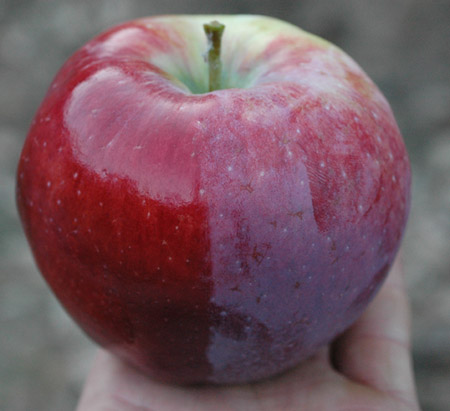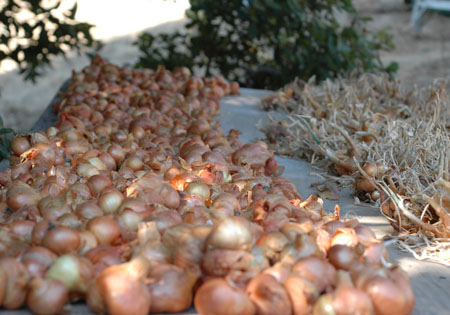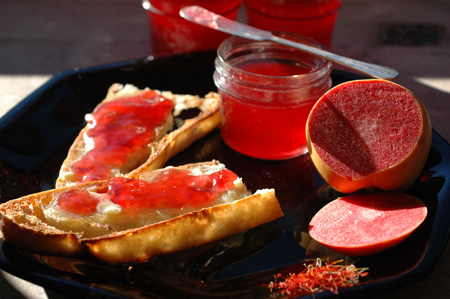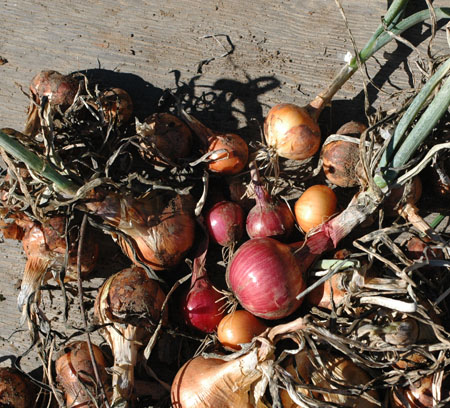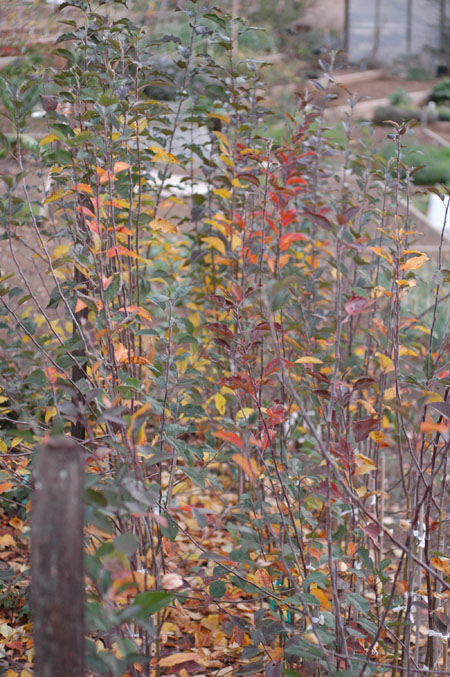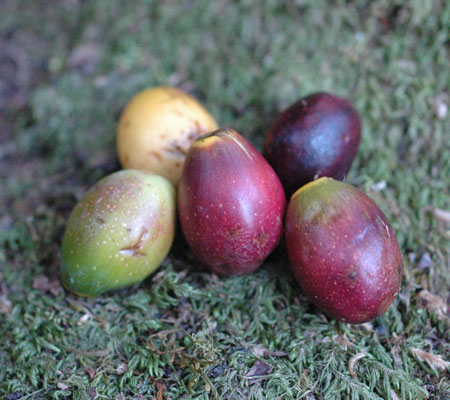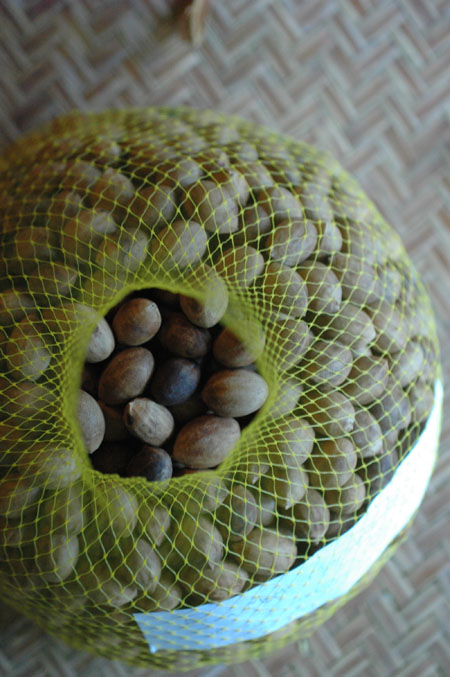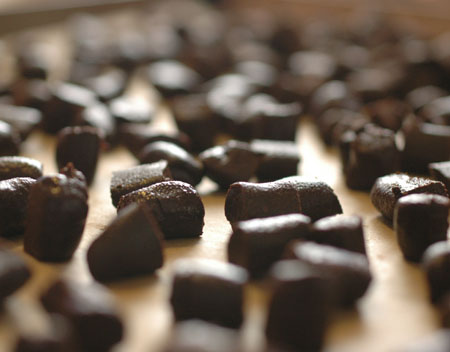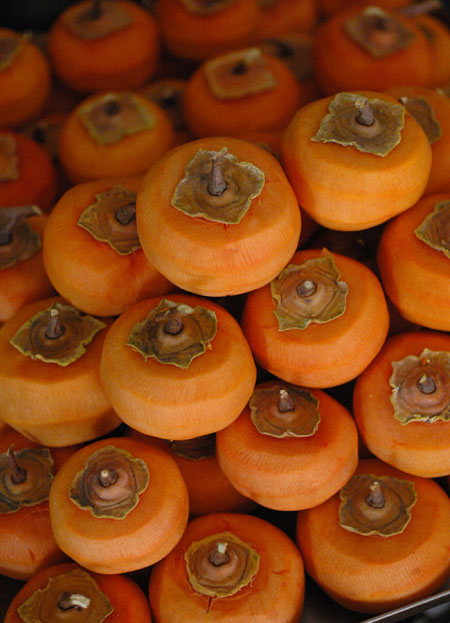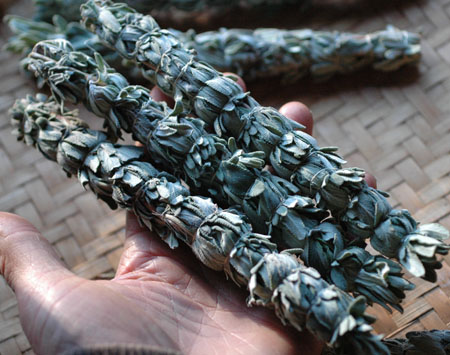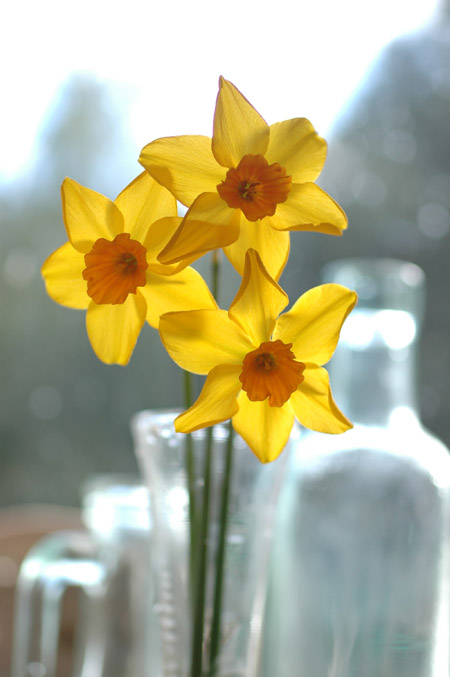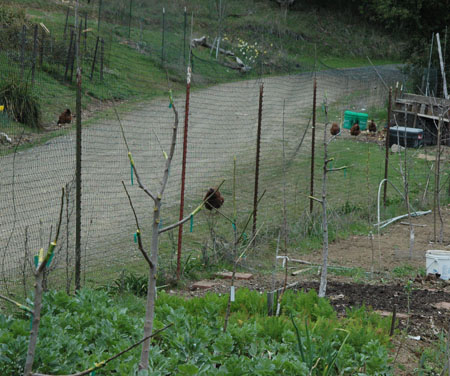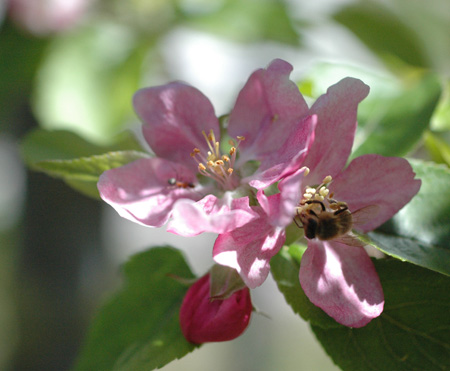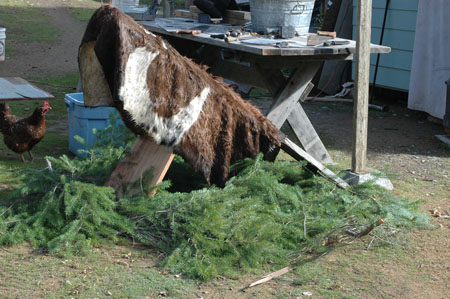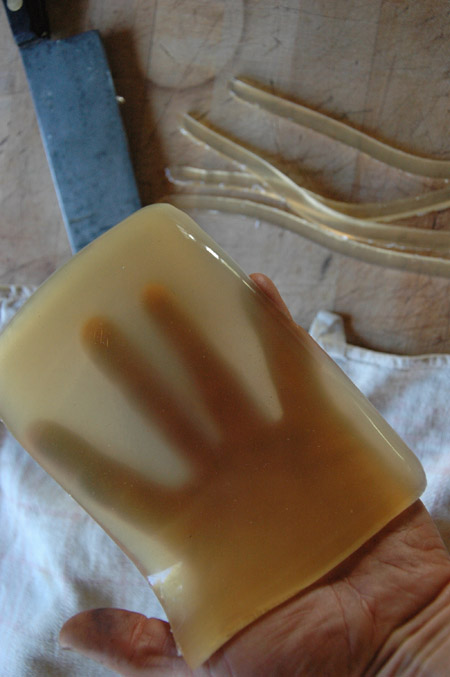Alligator lizard foreplay. They’d probably be less than thrilled to know they were modeling for exhibition on the web. They’ll run around like this for a while before they can get it up (cold blooded low metabolism at work I guess :). I’m sure it’s totally hot to be bitten on the head if you’re an alligator lizard chick. She looks stoked.
Zapotec tomato is a good eating and salsa tomato. It didn’t turn out to be the great canner I hoped it would though, so it’s back to blue beech to fill that niche for now. Paul Robeson was a great slicer and is probably here to stay (thanks mom for introducing me to both of those varieties!). I usually have free seeds of my favorite tomatoes and vegetables at the farmer’s market in Ukiah, and at the winter scion exchange in Boonville. I have a huge basket full of folded seed pockets ready to go. They are almost like business cards.
Where the magic happens? Grapefruits gleaned from town with lots of sugar. According to the owners of this grapefruit tree, it produces fruit for about 11 months of the year. Yet there is really not that much citrus planted in Ukiah. Citrus trees are ornamental, easy to care for (usually needing very little if any care), the flowers smell good and they produce food that most people like, but which is relatively expensive to buy and is currently shipped in, often from long distances. WTF homeowners?
Curing potato onions. Selling potato onion starts on ebay has been a helpful income boost since fall.
Grinding charcoal sifted out of the wood stove and fire pit ashes. Every time I start a fire, I shovel out the cold ashes and charcoal from the last fire. As you can see, it adds up! I’ve pretty much abandoned this grinder for now, until I can restore it and set it to finer grind setting than the one it’s stuck on now, which is pea sized and down. Now I’m using a garbage disposal unit that was set up a few years ago for grinding apples for the juice press. It is much faster and makes a finer grind, though I sort of miss the meditative spinning of the wheel and knowing I was doing it with my own motive power.
The interstem trees that I did not graft over have come into pretty decent bearing. Being young, I had to thin them quite a bit this year to prevent limb breakage. They are tending to be suckery, but otherwise, I’d say this system is a success. They seem fairly self sufficient, grow fast and fruit early. The fruit quality is high so far.
The Hall apple has an interesting story. It was very highly respected at one time, but was nearly lost to cultivation because it was too small to compete in the markets as food shifted increasingly toward larger scale production and people purchased more and grew less. It was rediscovered by apple hunter Tom Brown (no, not the survival guy) who deserves major props for sleuthing out many old apples that would otherwise be lost forever. Go Tom! Hall was also grown in California at one time, and was of commercial interest, though it probably fell out of favor here for the same reasons. Being a southern apple, it was resistant to our hot summers. My few specimens this year were badly watercored, but that is likely to clear up as the tree matures. The flavor was intense, even early in the season, so I’m hopeful it will stand up to the benchmarks already set by other great apples grown here. This specimen is larger than average since it was grown on a cordon.
It was a good year for apples! Some gigantic and some tiny. Some delicious and some spitters. The cordon trees have really started to produce. They grow enormous apples. My only complaint is that the apples seem somewhat watered down compared to those off of my other apple trees, no doubt because of watering. I have to water them since they have small root systems and are crowded together, but I may cut back a little to see if I can get closer to the dry farmed taste intensity and sweetness of my other apples. I got to taste a lot of new apples this year and have lost count of how many are fruiting. I sold apples at the market and did a lot of impromptu tastings with people. I’ve gotten some good input and insights now and feel confident to move forward with planting a few more trees for market. I won’t be going large scale or anything. I like keeping a diversified farm economy, it’s safe and resilient, and way more fun! But I would like to be able to take more than a couple of boxes to market. I’m consistently impressed by my apples and disappointed in everyone else’s. I simply don’t take lame apples to market. Those are for the chickens or the juice press. All these years of research and trial testing varieties is paying off. I’m not sure if I’ll do an apple variety blog report this year, but you’ll certainly be hearing more about worthy and unworthy apple varieties sometime in the future. I’ve occasionally had my doubts about sinking so much time, thought and energy into the whole apple project, but tasting some great apples this year, and seeing people’s faces when trying them was very gratifying and has confirmed what my enthusiasm already knew. That should be no surprise since it was all done out of passion and usually the thing you are most compelled to do will bear fruit in some way eventually. That at least is how I’ve always lived.
Drying strawberries. This was in the spring. I just forgot to put it in the last post. Dried strawberries are intensely flavored, but I can’t say they are super fun to just eat. I haven’t really figured out what to do with them yet. I’ll be sure to let you know if I break the dried strawberry code, and let us know if you already have.
Leek seed heads. These represent the third or fourth generation of seed selected from Bulgarian Giant for height, girth, uprightness, cold hardiness and long smooth stalks. The gene pool is somewhat limited as I usually only save 8 plants or so, but I’m hoping to trade for some seed from Bulgaria this year to freshen up the gene pool! Lot’s of seed to give away this year. You might be surprised how much seed is produced by 8 leek seed heads! If you have been thinking about saving seed, but haven’t done it yet, my advice is to just start. Tomatoes are easy and don’t inter-cross. Lettuce is easy and also doesn’t cross out, so you can just let your best one or two plants go to seed. It gets more complicated from there, but you can worry about that later! Find the easy stuff and just start. Our seed supply and genetic diversity are seriously threatened by current trends. This is a real problem that we can all solve by taking control of our own seed supplies. We don’t have to save everything either. We can divide always trade too.
Saffron bulbs begining to sprout in fall. Each of those little shoots coming out the side will become a new bulb. I had them multiplied up to probably 800 to 1000 bulbs after starting with just 35 or so. Then a gopher discovered my nursery bed and kicked by butt. I lost about 2/3 of them, which at around 50 cents piece to replace them is a pretty big loss. The remaining were replanted in a new bed which was also discovered and the plants started disappearing underground one by one. I dug up all the plants, lined the bed with wire, and replanted. Take that suckas! I’m on a mission to grow saffron here. Obviously gophers and voles are going to be a major issue, but my gears have been spinning for several years to come up with possible solutions. Like so many things, there should be a local saffron industry in California, at least to cover local use. It is very easy to grow aside from the rodent issue.
Saffron root growing through a piece of “the pet”, a clay charcoal kiln that was pulverized and used to amend the saffron crocus bed. Burnt clay is supposed to be a good soil amendment. did this root find that hole in the fired clay and dive in? Or did it just bump into it and end up in there?
Dressing a piece of lat year’s bull hide. This piece of leather went to shoe maker Holly Embree and was used to make a pair of shoes for the fiber shed fashion gala. She was able to work with the chicken tracks that I couldn’t manage to dress out :/
Bay nuts galore this year! This picture shows the genetic diversity of the bay nut. I suspect that indicates a high potential for breeding for improvements in size, form, oil content, etc… After all, it’s relative the avocado was bred from a small, barely edible fruit. Look for a book from paleotechnics on bay trees and bay nuts this fall (you might not find it, but look anyway:)
The best drier. The car dashboards are in constant use every fall and much of the summer for drying stuff. There are more trays and boxes in the background. They haven’t all been weighed yet, but probably around 150 pounds total this year. I’ll be selling them on ebay and elsewhere.
Roating bay nuts in a popcorn popper, my new preferred method until I invent and build a better roaster.
Cracking bay nuts in the Davebilt nutcracker. This machine is manufactured and sold by a very nice old couple in Lake County. It can be set for any size of nut. It sure beats tapping each one with a rock! An investment, but a solid one if you crack nuts every year. It’s built like a tank.
Happiness is a full woodshed, but this shed is less than full. At least it’s half full and not half empty this year! It does have a nice stack of fat slabs of fir bark for lime burning projects! This bark is from 60 year old stumps, still solid and dense with a high fuel value. I like the florist sighn with half the F eaten off by a horse. That’s going to market this year. Very country chic.
Drying hachiya persimmons. These are so good! Persimmons are dried and eaten all over temperate asia, but are just being discovered by other-than-Asian Americans. I’m planning to plant more, but still deciding what varieties. The plants are productive, disease resistant, almost pest free and require little pruning. My neighbors let me pick about 150 fruits off of their 30 year old tree after they had already picked 550 large fruits! I never knew what to do with that many persimmons until I found out about drying them whole a few years ago. Early experiments went okay, but when tonia brought some back from chinatown, I realized the true potential and I’m all over it now. They’re like a giant natural gummy bear that’s been deboned, had it’s limbs and head removed and was given a hat and squished flat.. sort of. Persimmons are a great example of the latent resource potential concept I’m so into since moving here. After establishment, the long lived trees will produce persimmons whether they get used or not. They could be eaten, sold fresh, dried and sold, traded, gifted (part of any truly stable economy), fed to animals or just left to look pretty on the tree. Awesome. I’ll be learning more about persimmons and figuring out how to graft them. There is a great persimmon collection at Winters here in California with varieties from all over the world.
Happy birthday to you! The daughters of young love on their second birthday. Yay! Coming out party in a few years! And many mooore…
Hopefully the last smokey lime burn ever here at turkeysong. I only did it for pictures to finish off the lime burning in drums era with a blog post. All kinda plans for lime burning experimentation rattling around in here.
Lots of charcoal making experiments brewing in my head. The cone kiln concept using a pit is especially exciting. This guy is doing something similar in hawaii, though his burn strategy is a little different. I think there is huge potential here and will be experimenting if it ever rains around here. Thanks to reader Lars for pointing me in this direction.
A 60 year old lump of ossified douglas fir pitch. What could that possibly be used for? All kinds of stuff! In this case, making soot for use in manufacturing ink. I hope to illustrate all publications from here out with home made artist materials, the mainstay of which will be Asian style lampblack ink and turkey quill pens.
Collecting fir pitch soot (aka lampblack) off of a flat rock for use in ink making.
Hybrid amaryllis coming up under the interstem trees. I’ve got quite a few trees planted to these bulb as an understory, now and will start seeing some results (or lack of) soon. Unfortunately, these ones go beat pretty hard in an extended freeze just after this was taken. Most of them seem like they’re recovering. I’m probably right about at the limit of what they’ll tolerate weather wise.
This is the apple that Greenmantle nursery trademarked under the name Pink Parfait™. My apple guru says it’s the best of the Etter blood apples, and I’m becoming inclined to agree. It is not as red or as intensely flavored, but it does have some of the same fruit punch/berry aromatics and it is a very pleasant eating experience with an outstanding juicy open texture. The flesh seems to disappear as you chew it. It also ripened very late for me (later than anything but lady williams!), hung very tight to the tree and survived an extended hard freeze in stellar condition. But wait, there’s more! It’s quite beautiful and sweeter than many of them as well. All in all an excellent apple (at least this year here in California. Our mileage will probably vary). Now if we can only get this kind of quality with more pigmentation and more red flavor. Thanks Albert! I wish you could have lived long enough to see your work really appreciated.
Thanks for tuning in this year! The Turkeysong blog had 24,000 views in 2013, many of them from people searching the web for relevant information of some kind, which I hope they found (although searches for "How to grow a big ass" and "leek in ass" continue to trickle in as well and I hope those people weren't too disappointed). Subscriptions continue to grow and I've got plenty more to say!
I'm hoping, if I can, to start an income stream from writing and blogging, so that I can keep doing this. That will mean more books published and probably affiliate links to amazon on the blogs (Don't worry, I'm not going to try to sell you anything you don't need. I'm all about people buying less physical stuff and doing things for themselves. That's practically a mission for me. Most of them will be to books I write and maybe other books or products that I review, like the gophinator trap.) I'll probably stay away from advertising altogether, because it's just so annoying, and again, I don't want to sell people anything they don't need, because that's half of the worlds problems in a nutshell. Or if so, they will be extremely select. I should be moving to a domain too so I can get rid of the ads that come up on these free wordpress domains.
I really like blogging. Exploring new and old ideas and techniques, and sharing relevant information, are at the core of my being and always have been. I'm at something of a cross roads with the blogs and plans for other projects. I have some other blog ideas, but don't want to get spread too far out, or over-complicate things. When I started this blog, I thought it would cover all of my interests and ideas, representing the diverse enigma that I am. Since I was so immersed in homestead stuff at the time, and realized that I had built a small audience around that interest, I decided to branch off and put primitive tech stuff on the Paleotechnics site. I feel a little disjointed though, because I'm all about the integration of ideas, old and new. Being intensely immersed in paleotechnology stuff for a long time in my 20's gave me a valuable insight into environments and of the potential for all kinds of materials to be turned to use. That has been invaluable in helping me see the land, and basically everything, as a resource-scape full of potential, as well as being a sort of organism that I play a part in. Part of my philosophy is that we should aim not to reject ideas and practices categorically, but rather that it behooves us to view things for what they are and what they do and don't have to offer in the view of a larger context, and integrate or reject them accordingly. Sounds reasonable I know, but we have a strong tendency to think in black and white categories and build identities around what we are and aren't, what we do and don't do and what is and isn't too new, too old, too whatever. I'm sorely tempted to throw all my ideas and projects, new and old, together in one place and let everyone sort it out. While I don't want to alienate a specific audience either, it occurs to me sometimes that I should just write for an audience of diverse interests. On the other hand, I respect that everyone doesn't want to hear what I think about The politics and social ills of the marijuana black market economy in Northern California, or Rife machines, or how to make a stone bowl using just rocks, or a pimped out chicken powered composting system.
I also can't always find my voice when writing for different audiences. In some ways, I can best reach my generation and younger people, because we've lived in the same times and speak, to some extent, the same language. My generation is coming into positions of power and greater influence now and could use a little shaking up. (If you were to ask me, which apparently you don't have to :D.
One thought is to have a central blog that covers everything I do and will serve as a sort of news feed. That site could have just links to my other blogs and projects, or entire posts replicated. Also, anything that didn't really fit in on a another blog would go there. That is appealing in some ways, and may be the best solution, but also sounds complicated and will increase computing time and thereby decrease working time.
I'd appreciate anyone's input on these ideas and thoughts and perspectives on this blog and/or the paleotechnics blog. What you do and don't want to hear about, what you appreciate or could do without and ideas about structuring content in one place or across multiple sites, or just whatever.
Oh yeah, and once I scrounge up enough money to get a decent video camera, I'm hoping to start a TOTALLY BAD ASS YOU TUBE CHANNEL. Or is it two channels? or three? See, more spreading out :/





